 |
|
Making learning and work count
Labour market LIVE from Learning and Work Institute
14 December 2021
- Unemployment is 1,423,000, down by 25,000 from last month’s published figure (quarterly headline down by 127,000). The unemployment rate 4.2%, is down by 0.1 percentage points on last month and down by 0.4 percentage points on last quarter.
- The ONS figure for claimant unemployed is 1,969,800, down by 49,800 on last month, and the claimant rate is 4.9%.
- The number of workless young people (not in employment, full-time education or training) is 900,000, up by 19,000 (0.7 percentage points) on the quarter, representing 13.2% of the youth population.
- Youth unemployment (including students) is 459,000, and is down by 66,000 on the quarter.
- Vacancies in Sep-Nov 2021 rose 37,000 to 1,219,000.
- There are now 1.2 unemployed people per vacancy, the lowest on record.
- The employment rate is 75.5% (no change on last month’s published figure and up by 0.2 percentage points in the preferred quarterly measure).
Learning and Work Institute comment
The labour market figures published on 14 December indicate a continuing improvement in the labour market. Today’s numbers now include data for October and November after the Coronavirus Job Retention Scheme (CJRS) finished at the end of September. There is some evidence that the ending of the CJRS had a temporary negative impact on the labour market in October but no indication that this has been sustained into November. Due to the emergence of the new Omicron COVID variant, the outlook for the labour market into 2022 is now highly uncertain.
Duncan Melville, Chief Economist at Learning and Work Institute, commented:
"The labour market continued to recover in October and November. Today’s headline Labour Force Survey (LFS) numbers show an increase in employment of 149,000 in the three months to August to October 2021 - a substantial increase albeit a slowdown on the very large quarterly increases reported in the previous three months. The timelier HMRC employee payroll numbers show increases of 257,000 in the month to November, and 331,000 in the two months since the CJRS finished in September. The November increase is the largest monthly increase in record and is driven by inflows onto payrolls - so new job creation.
Unemployment fell substantially - by 127,000 - in the three months to August to October 2021, while inactivity rose slightly in the quarter. Over the pandemic rising worklessness has been reflected much more in higher inactivity than higher unemployment.
Today’s numbers suggest that the prospects for continuing employment growth into November and December remained good. According to the ONS, vacancy levels continued to grow to a new record high of 1,219,000 in September to November. More recent data is somewhat mixed. The single month ONS vacancy numbers for November showed a fall of 80,000 in the month (note these numbers are not seasonally adjusted, so seasonal effects could be part of the explanation for this fall). However, this monthly figure of 1,227,000 remains very high by historic standards. Data on job postings from Indeed suggest that vacancy levels continued to increase through to early December. It should be noted that in part these very high vacancy levels reflect some employers’ difficulties in finding staff across a range of sectors and occupations.
Looking further ahead the outlook for the labour market is now unclear. Economic growth has already slowed. Additionally, we now face uncertainty as to the economic impacts of Omicron and the measures that have been taken, and further measures that may in future be taken, to limit its spread.
Did the end of the CJRS in September have a negative impact on the labour market? The single month LFS data raises that possibility. According to these numbers, employment fell by 143,000 and unemployment increased by 78,000 in October. In addition, the monthly increase in payroll numbers in October was much lower than those seen in recent months: apart from October, the monthly increases have been in six figures since April. This smaller increase was driven very largely by outflows from payrolls - so people losing or leaving their jobs. However, other evidence does not suggest a negative impact from the ending of CJRS. The claimant count fell by 58,000 in October and the number of redundancies in the month did not show any pickup.
Whatever the impact in October, there are no signs of any negative impact from the end of the CJRS continuing into November. The claimant count fell by 50,000 in November, while as already noted payroll numbers recorded a historic high increase in this month. Hence, any negative impact in October appears to have been only temporary and not sustained.
Looking towards 2022, as noted, the outlook for the labour market is now highly uncertain due to the emergence of the new Omicron COVID variant."
Paul Bivand, Associate Director for Statistics and Analysis at Learning and Work Institute said:
"Most of these figures date from August to October 2021, with just one month after the end of the furlough scheme. None of the figures include information after the renewal of work at home where possible advice following the arrival of the coronavirus omicron variant. As always, information from surveys has a margin of error. The charts showing weekly estimates also show just how large those margins of error can be."
Employment increased by 149,000 between May to July 2021 and August to October 2021. In the last 12 months employment is up by 193,000 but still 296,000 below two years ago.
Unemployment fell by 127,000 between May to July 2021 and August to October 2021 and the unemployment rate fell by 0.4 percentage points to 4.2% in the quarter the lowest level since April to June 2020.
Economic inactivity has risen by 35,000 between May to July 2021 and August to October 2021 and the inactivity rate increased by 0.1 percentage points to 21.2% in the quarter. Economic inactivity has risen 141,000 since two years ago.
The national claimant count fell by 49,800.
Youth unemployment is down by 66,000. There are 459,000 unemployed young people, and 292,000 (4.3% of the youth population) who are unemployed and not in full-time education.
Self-employment decreased by 156,000 this year. The number of employees rose by 343,000 over the year. Involuntary part-time employment is up by 7,000 this quarter to 987,000, 12.4% of all part-time workers. |
 |
Chart 1: UK unemployment (ILO)
The unemployment rate fell by 0.1 percentage points on last month's figure to 4.2%.
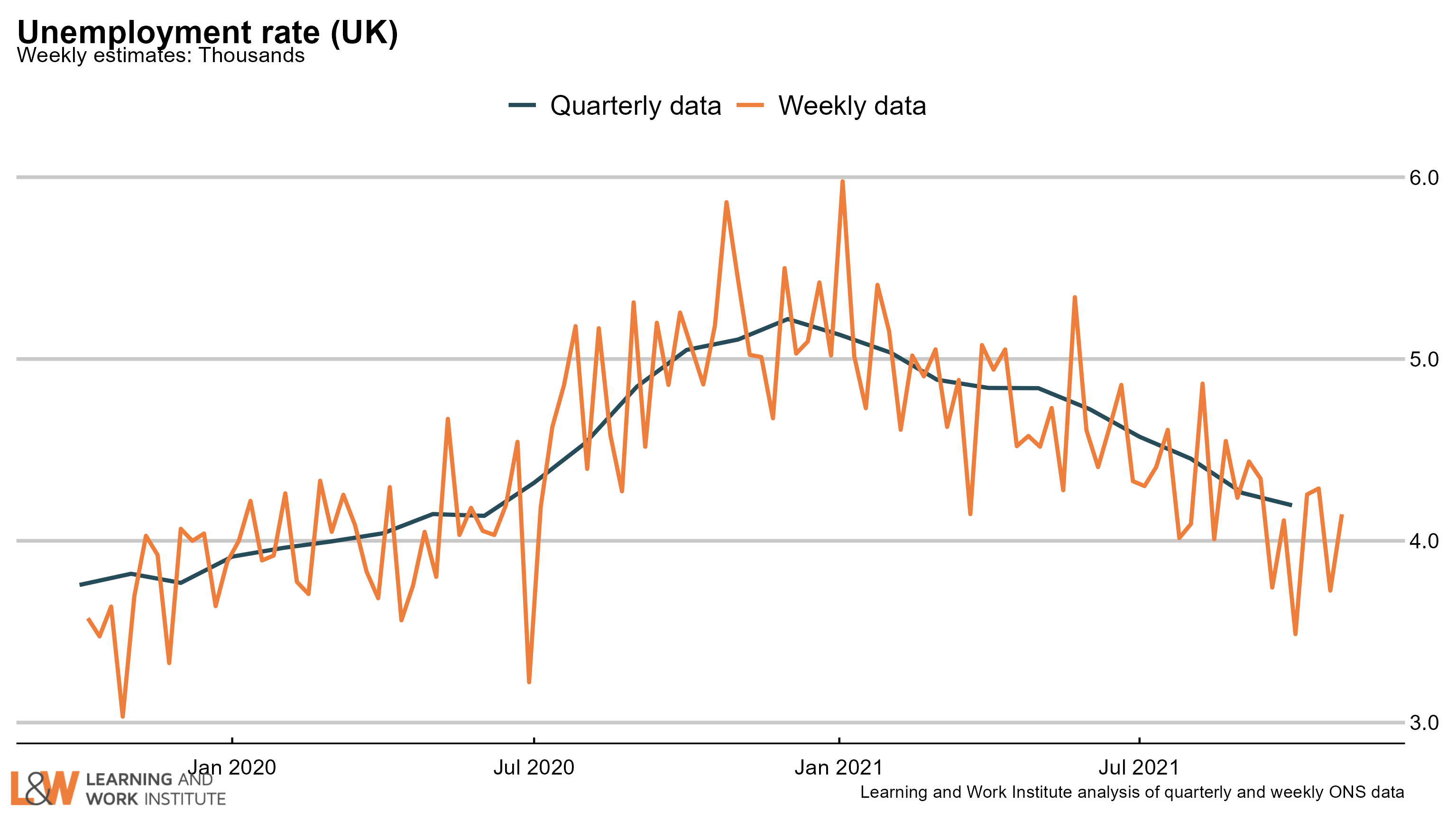 |
 |
Chart 2: The claimant count and UK unemployment compared
The number of unemployed people who are claiming unemployment-related benefits is now 546,400 higher than the number of unemployed in the official measure (as shown in Chart 1).
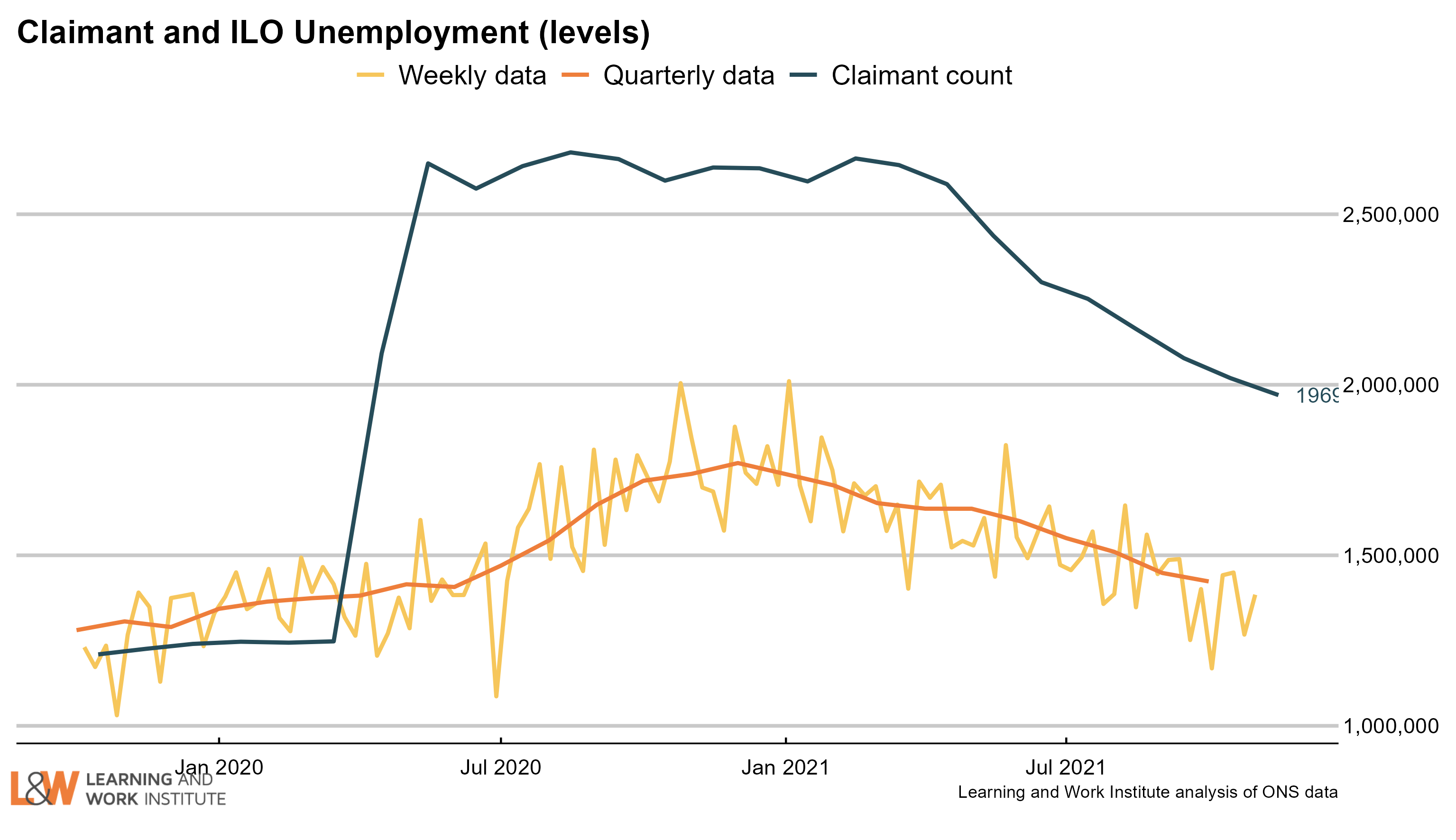 |
 |
Chart 3: Youth unemployment
The number of unemployed young people is down by 17,000 since last month’s figures, to 459,000.
Meanwhile, the number of young Universal Credit or Jobseeker’s Allowance claimants fell by last month by 8,400, to 332,900.
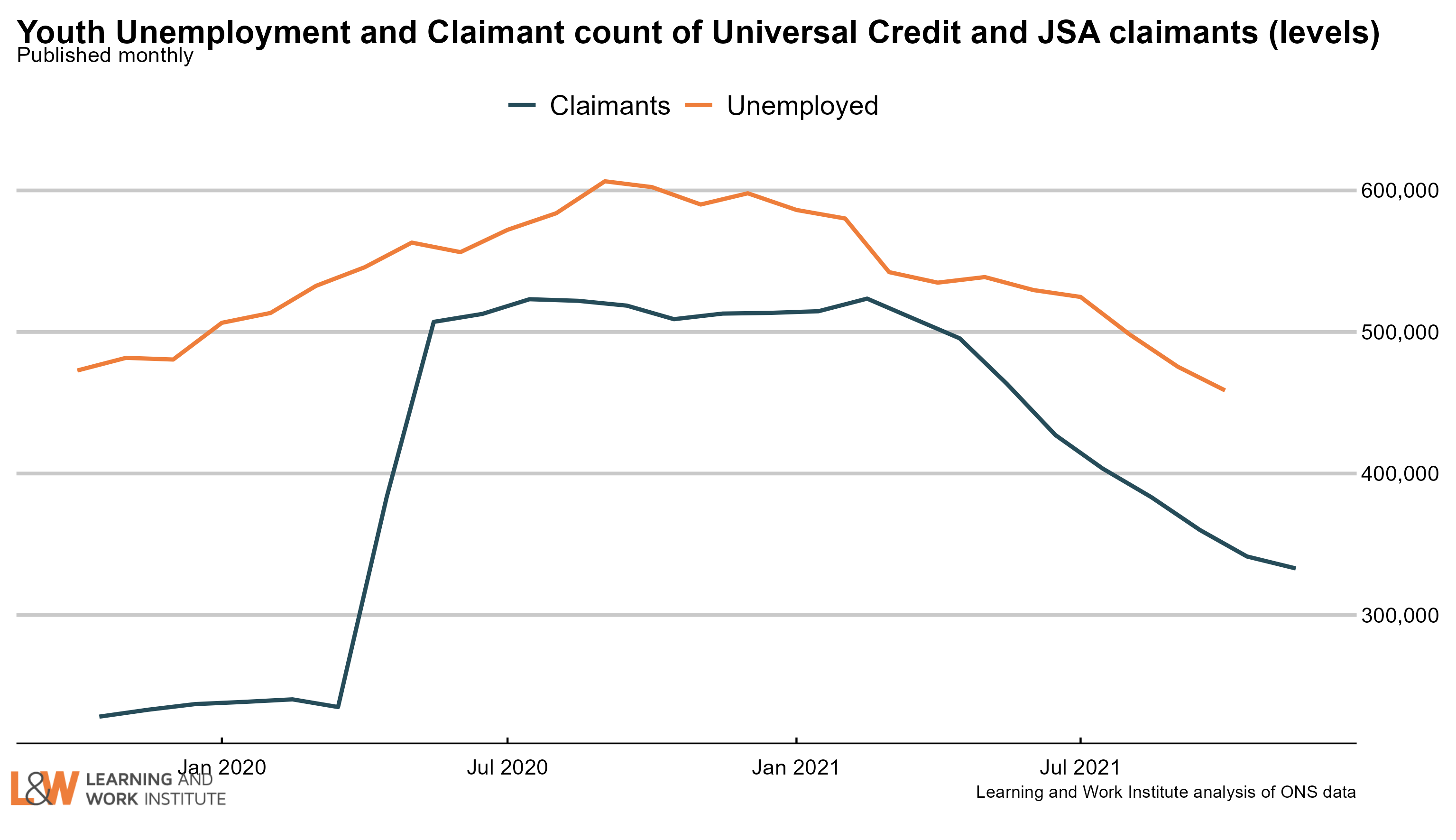 |
 |
Chart 4: Young people not in employment, full-time education or training
The number of out of work young people who are not in full-time education (900,000) rose by 49,000 in the last quarter, or 5.8%. The rise was among the inactive, with the number of unemployed young people not in full-time education or training falling. The economically inactive are those not working and not currently looking for work.
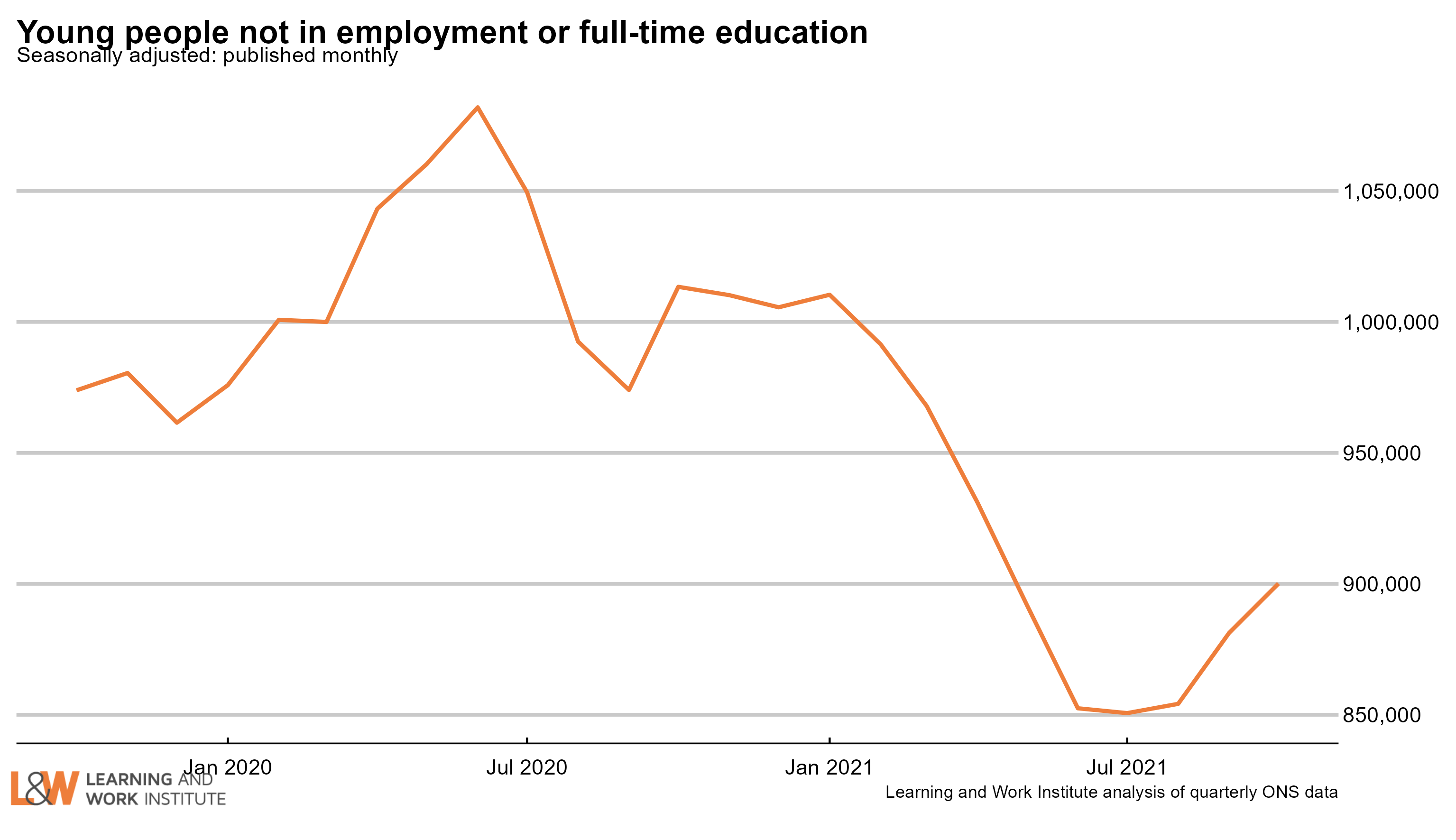 |
 |
Chart 5: Youth long-term unemployment (six months and over, 18-24)
Youth long-term unemployment (which can include students) has fallen by 37,000 over the last quarter and is now 156,000
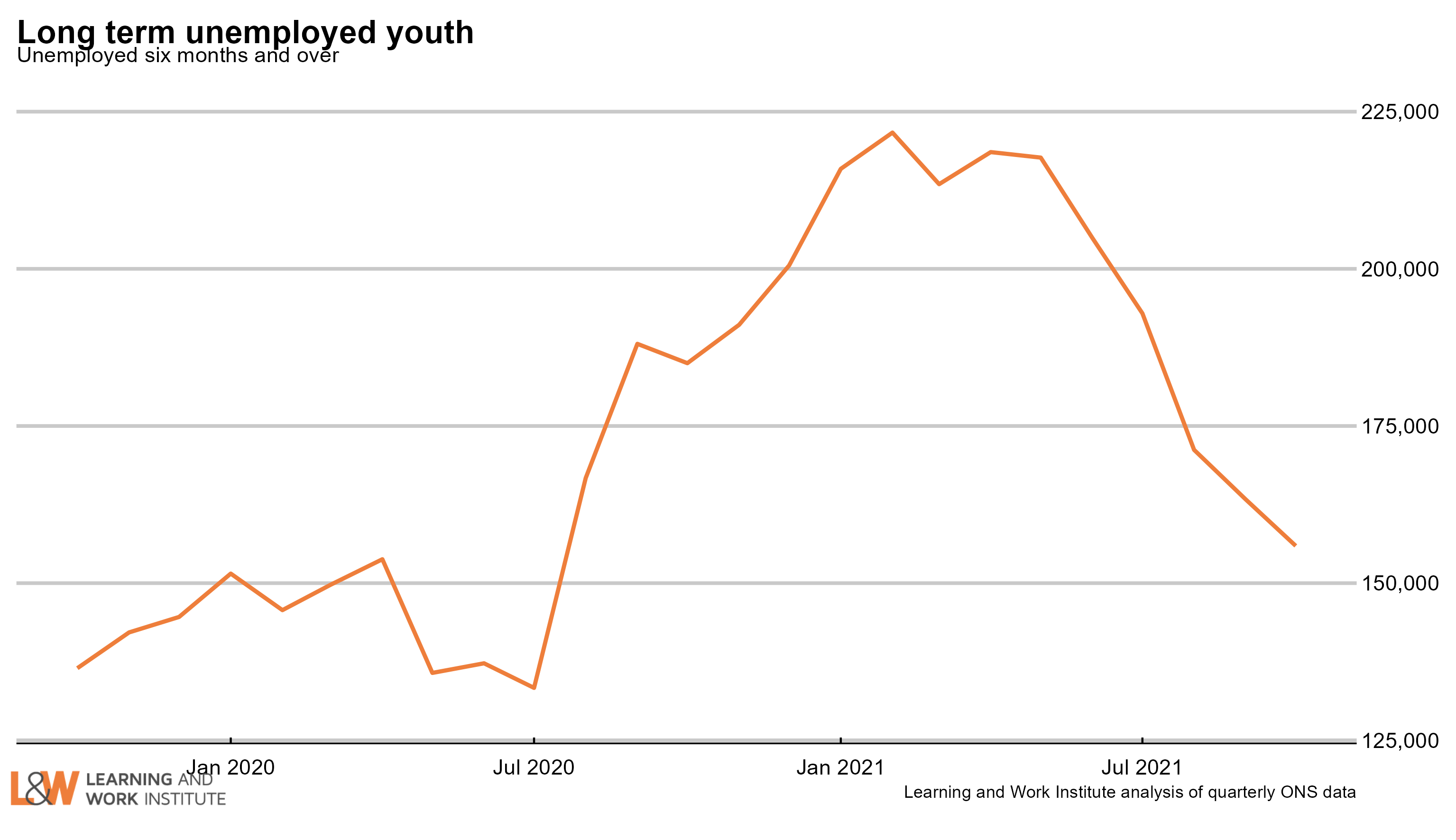 |
 |
Chart 6: Adult long-term unemployment (12 months and over, 25+)
Adult long-term unemployment on the survey measure is now 351,000. This is down 19,000 on last month's figure.
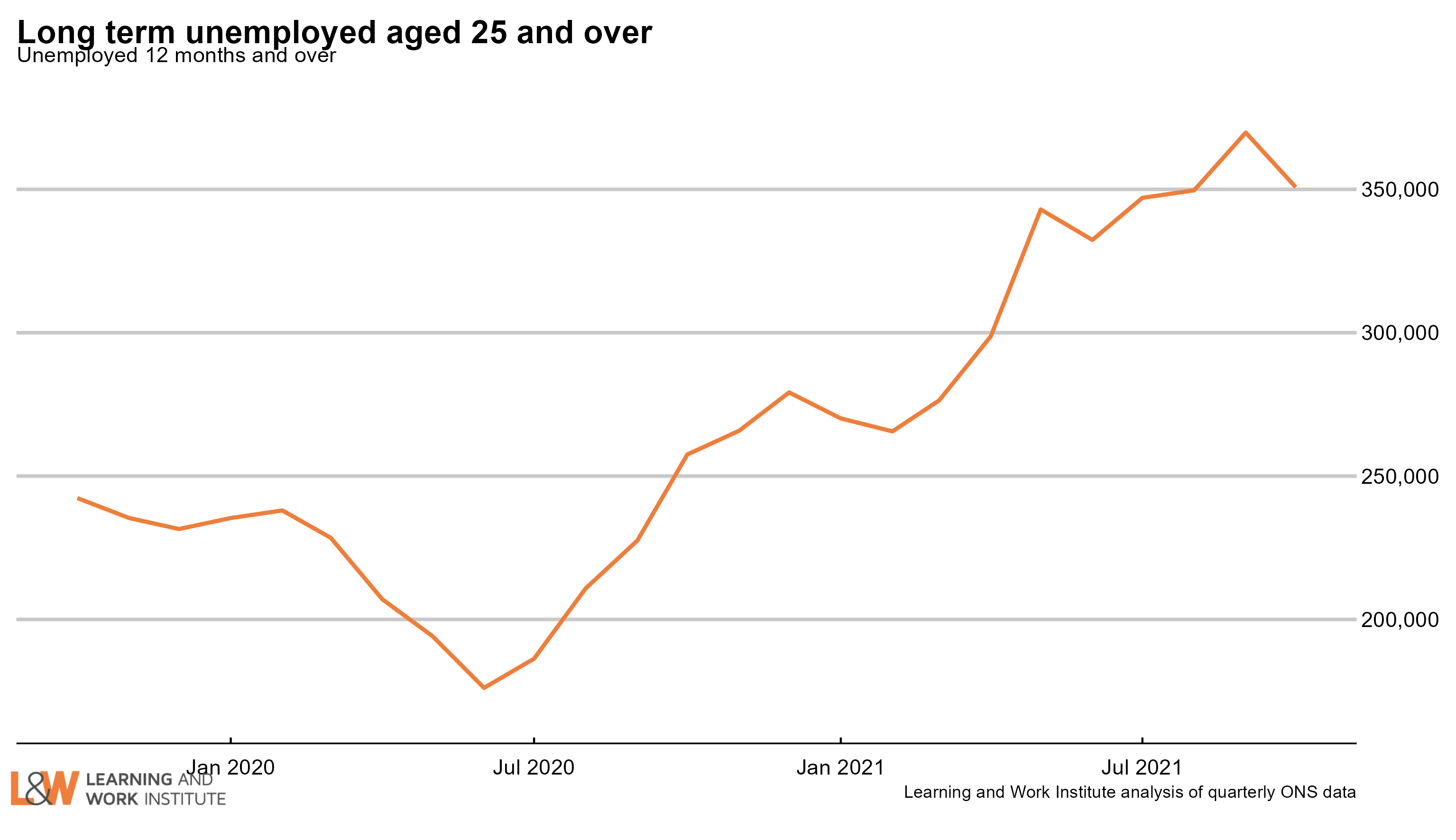 |
 |
Chart 7: Unemployment rates by age
The 18 to 24 year old unemployment rate (including students) is 10.0% of the economically active – excluding one million economically inactive students from the calculation. The rate for those aged 25 to 49 is 3.2%. For those aged 50 and over it is 3.3%. The quarterly change is down 1.1 percentage points for 18 to 24 year olds, down 0.4 points for 25 to 49 year olds, and up 0.1 points for the over-50s.
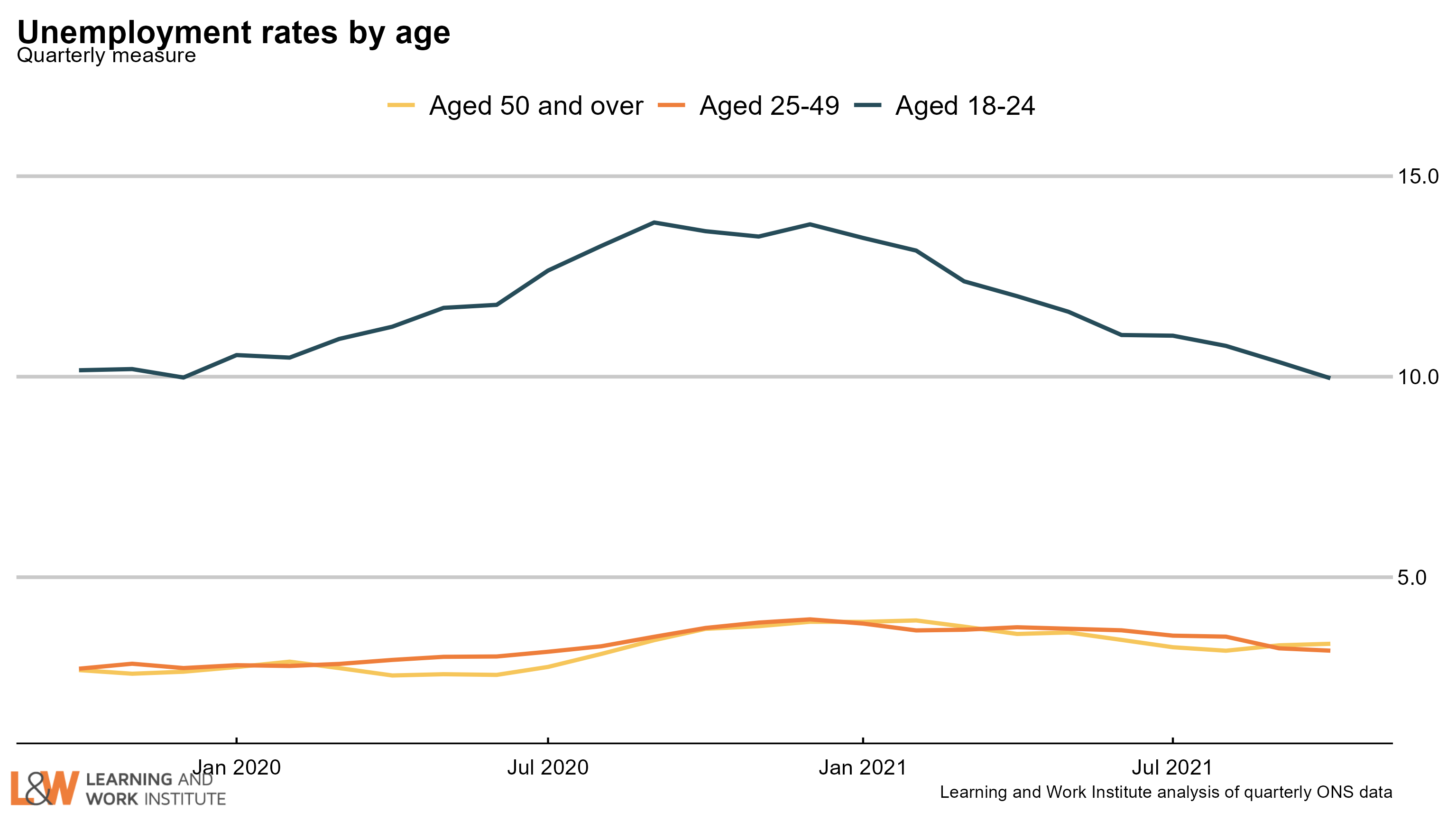 |
 |
Chart 8: Unemployment rate changes by age (counting February 2020 as 100)
The 18 to 24 year old unemployment rate (including students) is 0.5 percentage points down on February 2020. The change for those aged 25 to 34 is 0.5 percentage points up. The change for those aged 35 to 49 is 0.3 points up. The change for those aged 50 to 64 is 0.5 points up. The change for those aged over 65 is 0.2 points up.
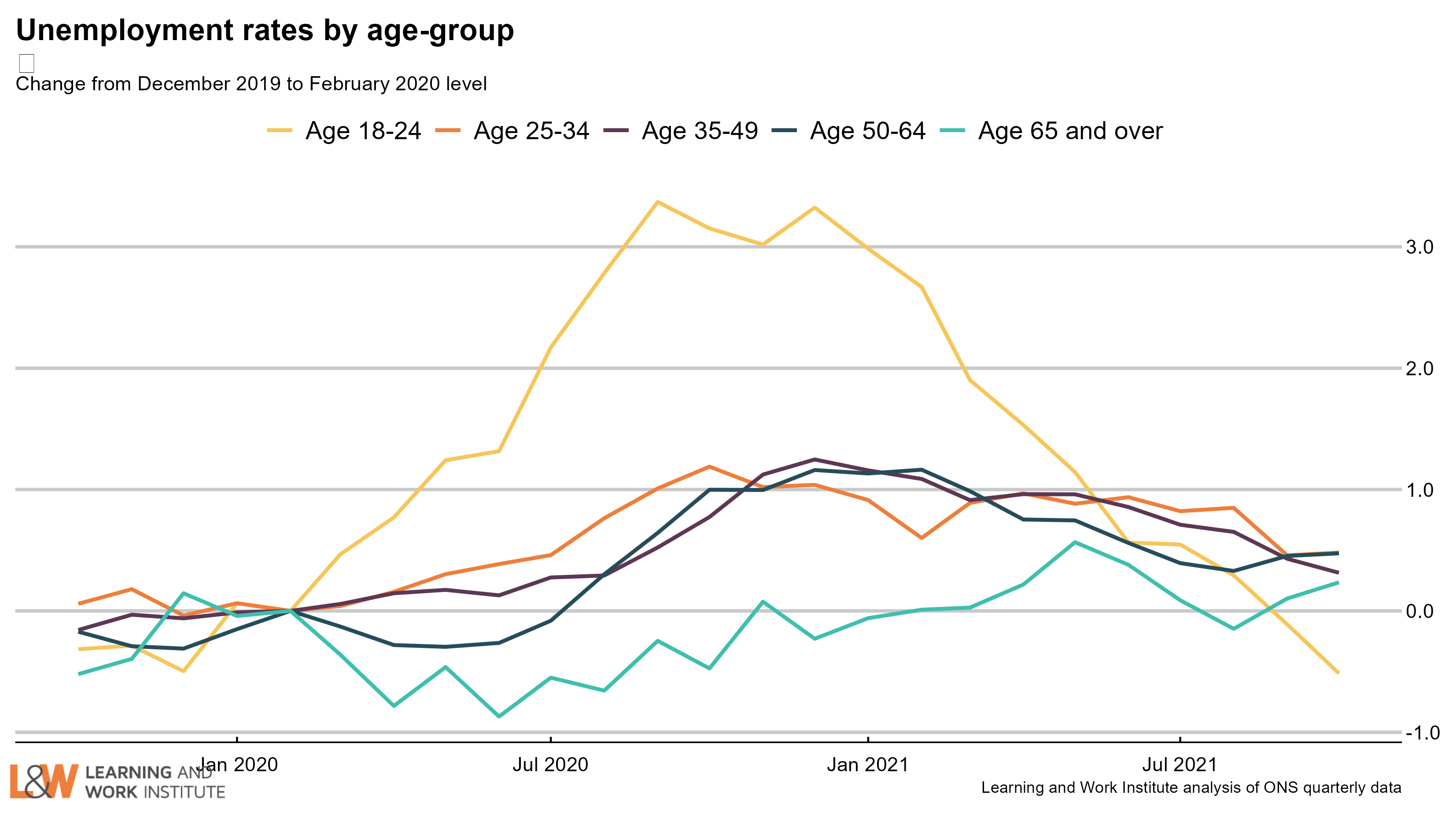
Chart 9: Vacancies – whole economy survey
Headline vacancies this month have risen by 37,000 to 1,219,000. The ONS' experimental single-month vacancy figures has risen by 69,000 to 1,227,000 in the last quarter. The headline ONS vacancy figure is both seasonally adjusted and a three-month average. The chart shows both series. 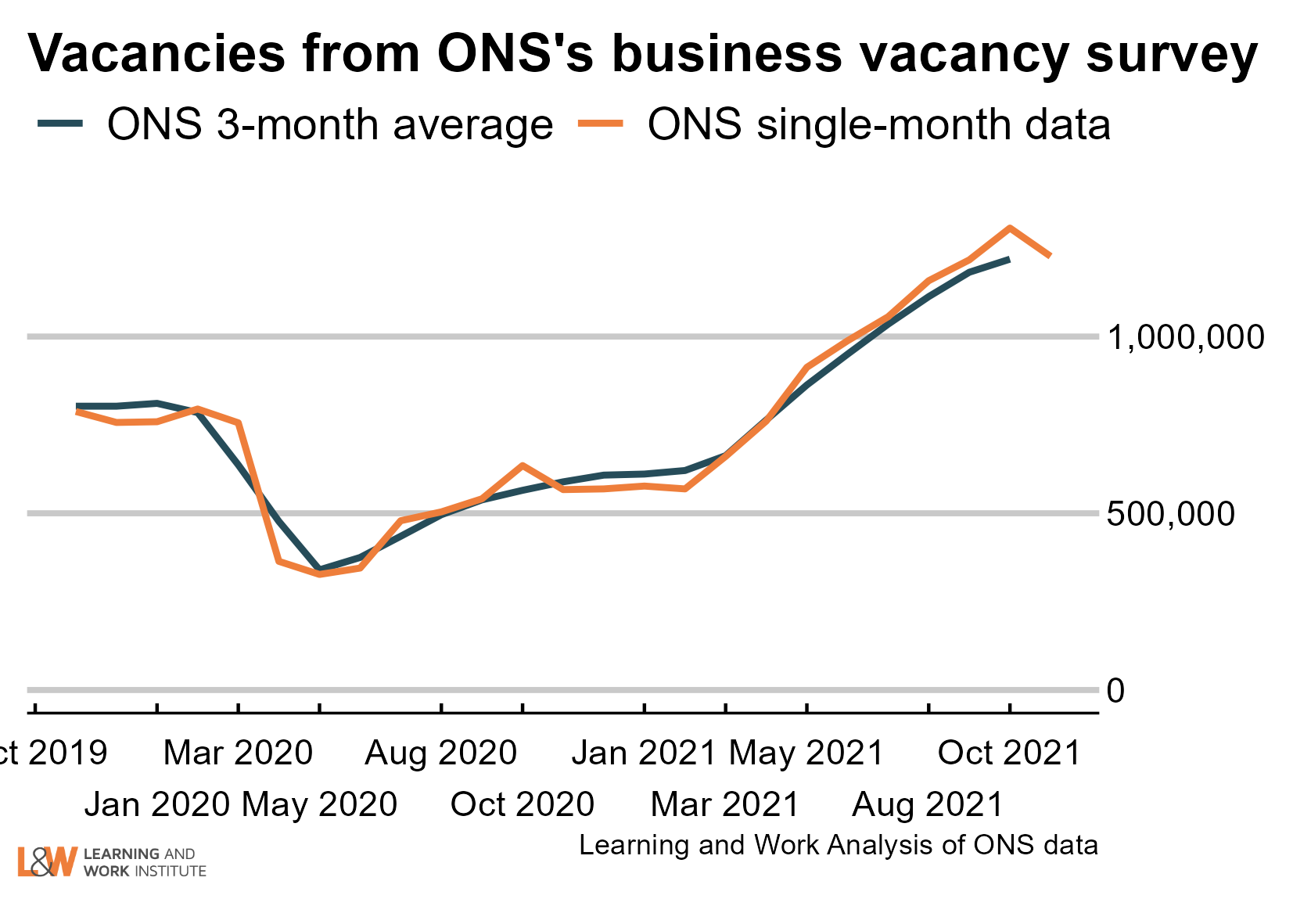 |
 |
Chart 10: Experimental single month vacancies – whole economy survey
The Office for National Statistics' experimental single month vacancy estimates include sectoral information. Here, we show the changes on the same month two years ago, before the pandemic. The data is not seasonally adjusted, so comparisons with the same month each year are better. The numbers are thousands of vacancies, under each number, and on the right, the change in thousands of vacancies.
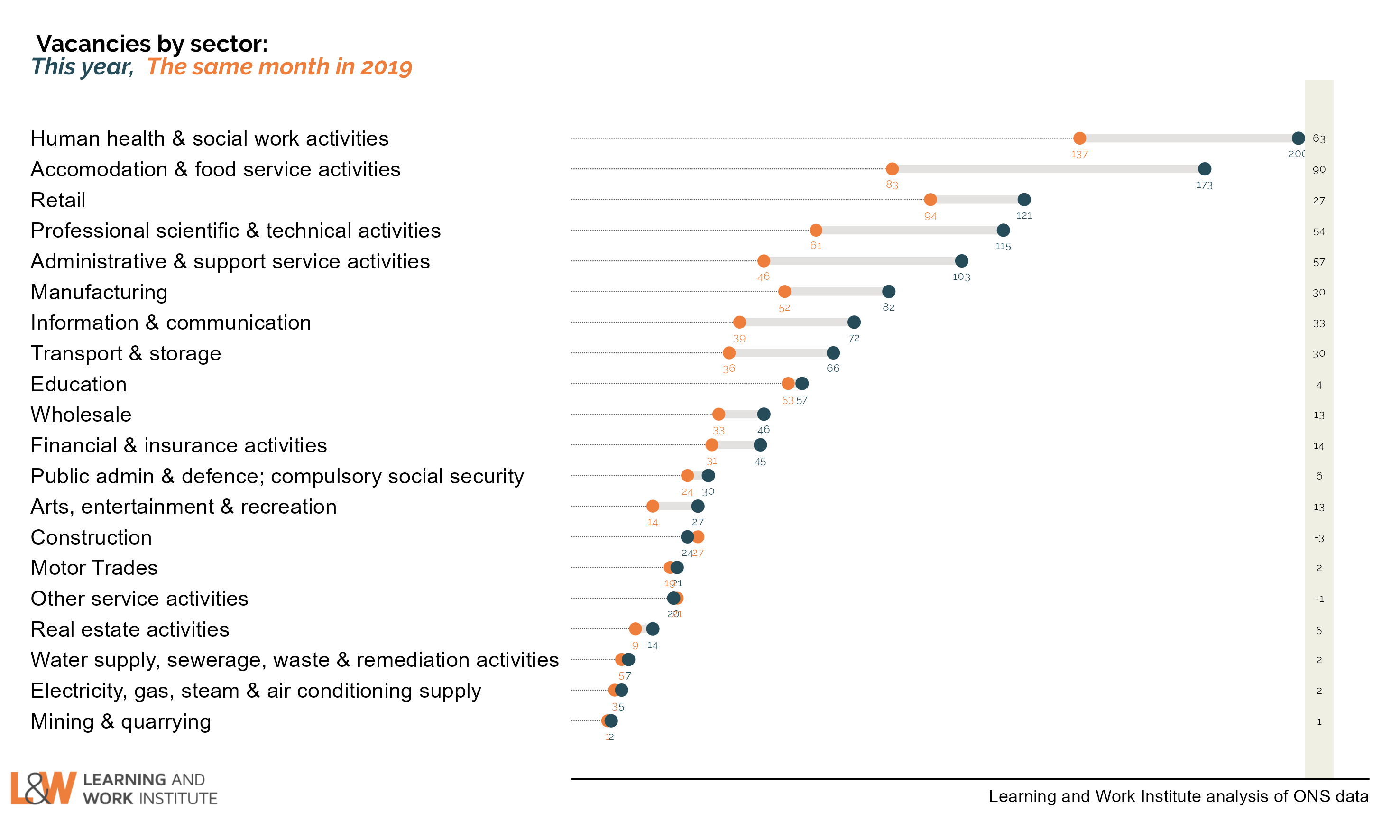 |
 |
Chart 11: Unemployed people per vacancy
There are 1.2 unemployed people per vacancy. This is now the lowest since the series started in 2001. 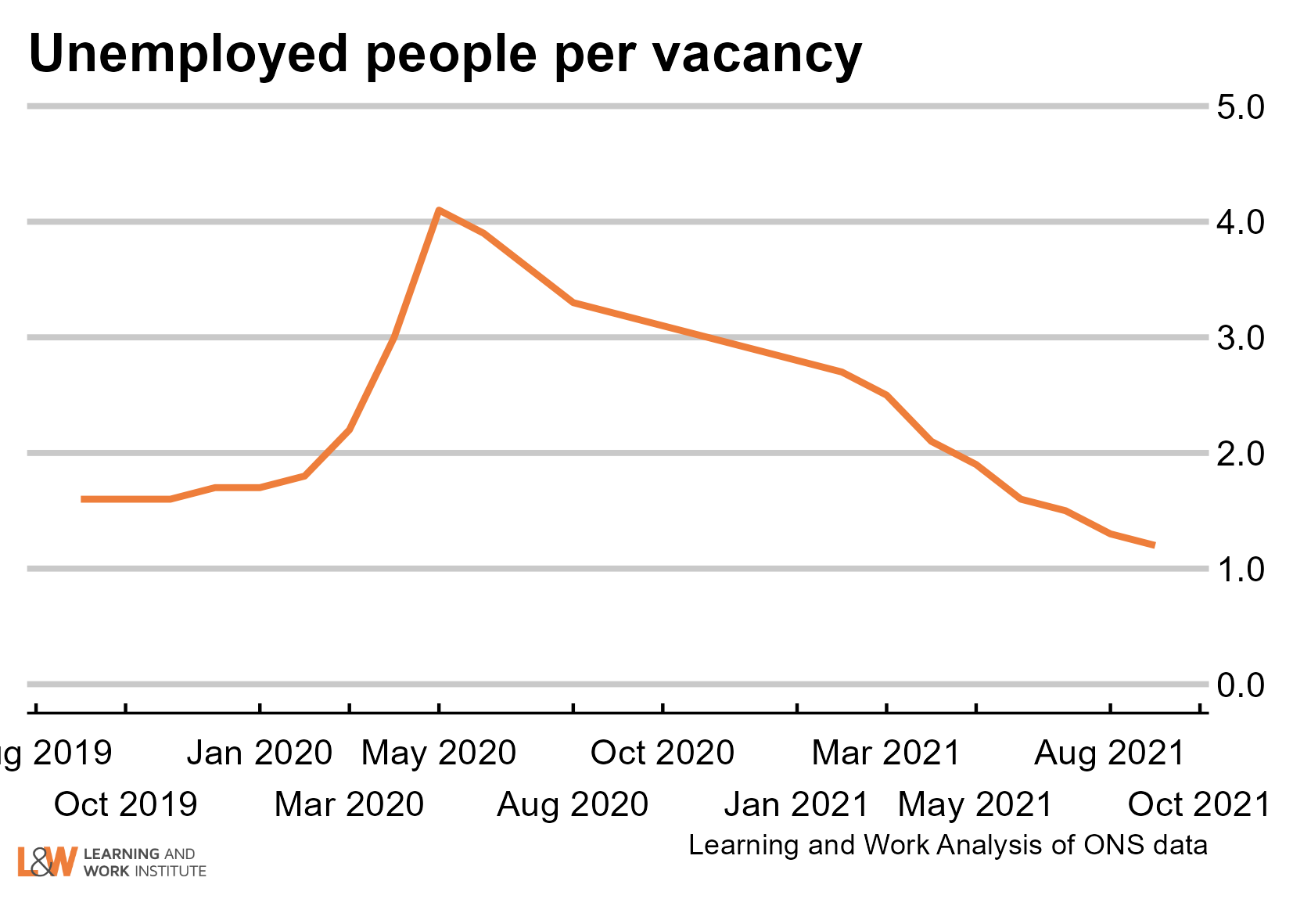 |
 |
Chart 12: Online vacancies to early December from Indeed
This release we are including figures from Indeed as the ONS release did not include online vacancies this week. Indeed release figures fortnightly giving their information on vacancies. They distinguish new postings (within the previous seven days) from the total currently available. 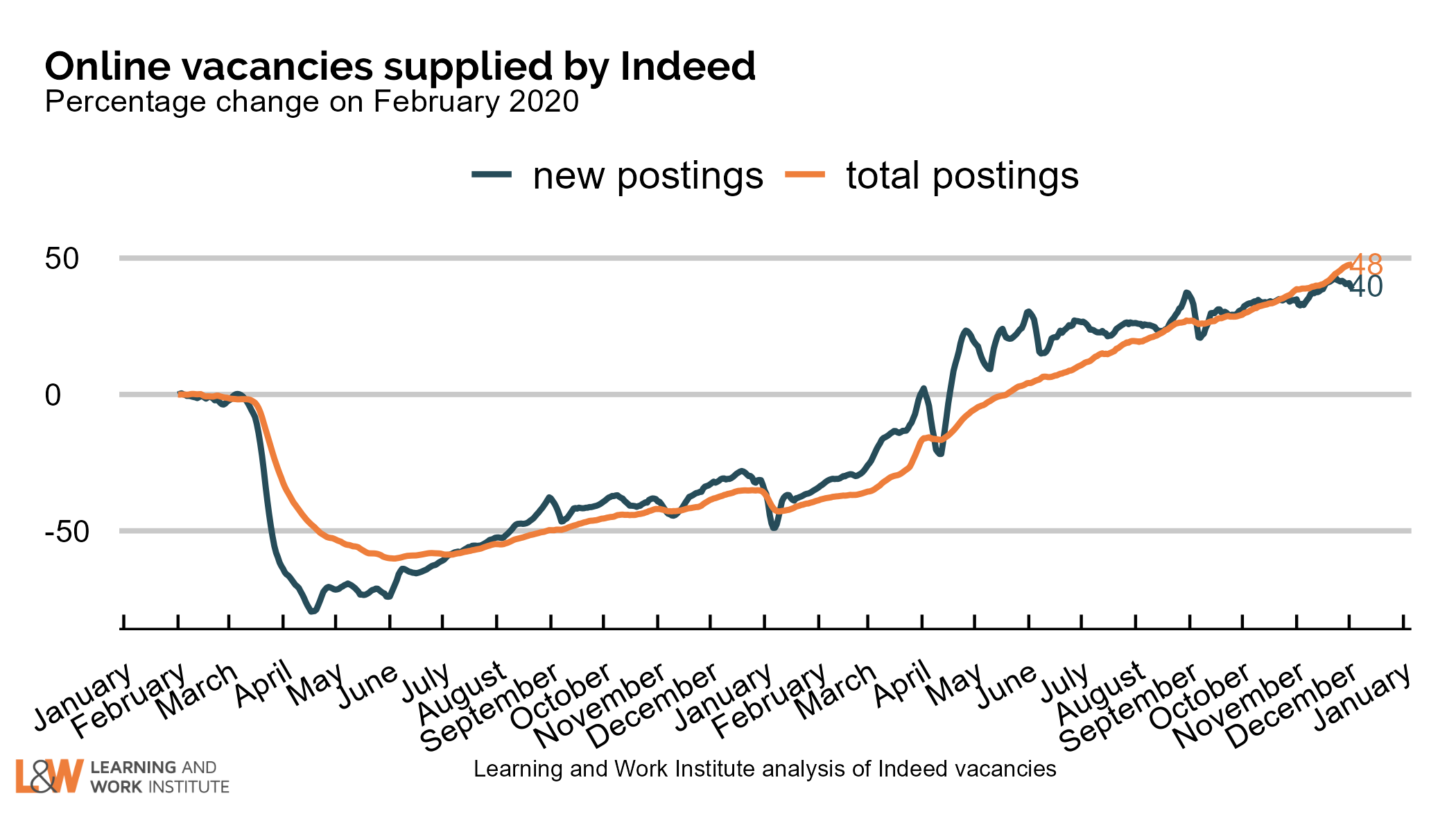 |
 |
Chart 13: UK employment
Employment fell by 18,000 on the figure published last month, to 32,506,000. The chart shows both the official figures and the experimental weekly figures. The trend is likely to be flat.
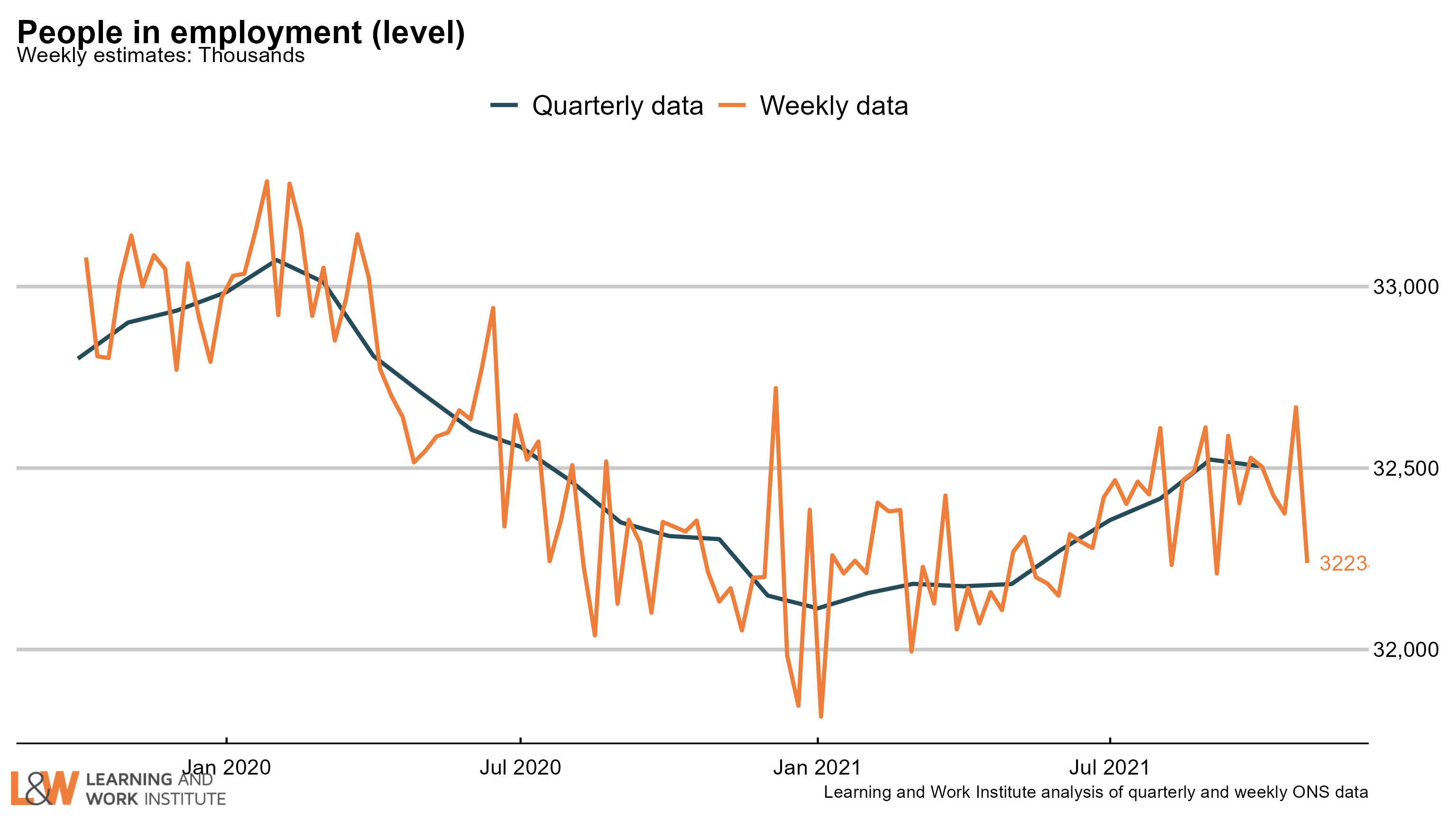 |
 |
Chart 14: Employment rate in the UK
The employment rate increased by 0.2 percentage points over the quarter, to 75.5%. The rise is smaller than the previous quarter (0.5 percentage points) when recovery was at an earlier stage. The chart shows both the official figures and the experimental weekly figures. The trend is likely to be flat.
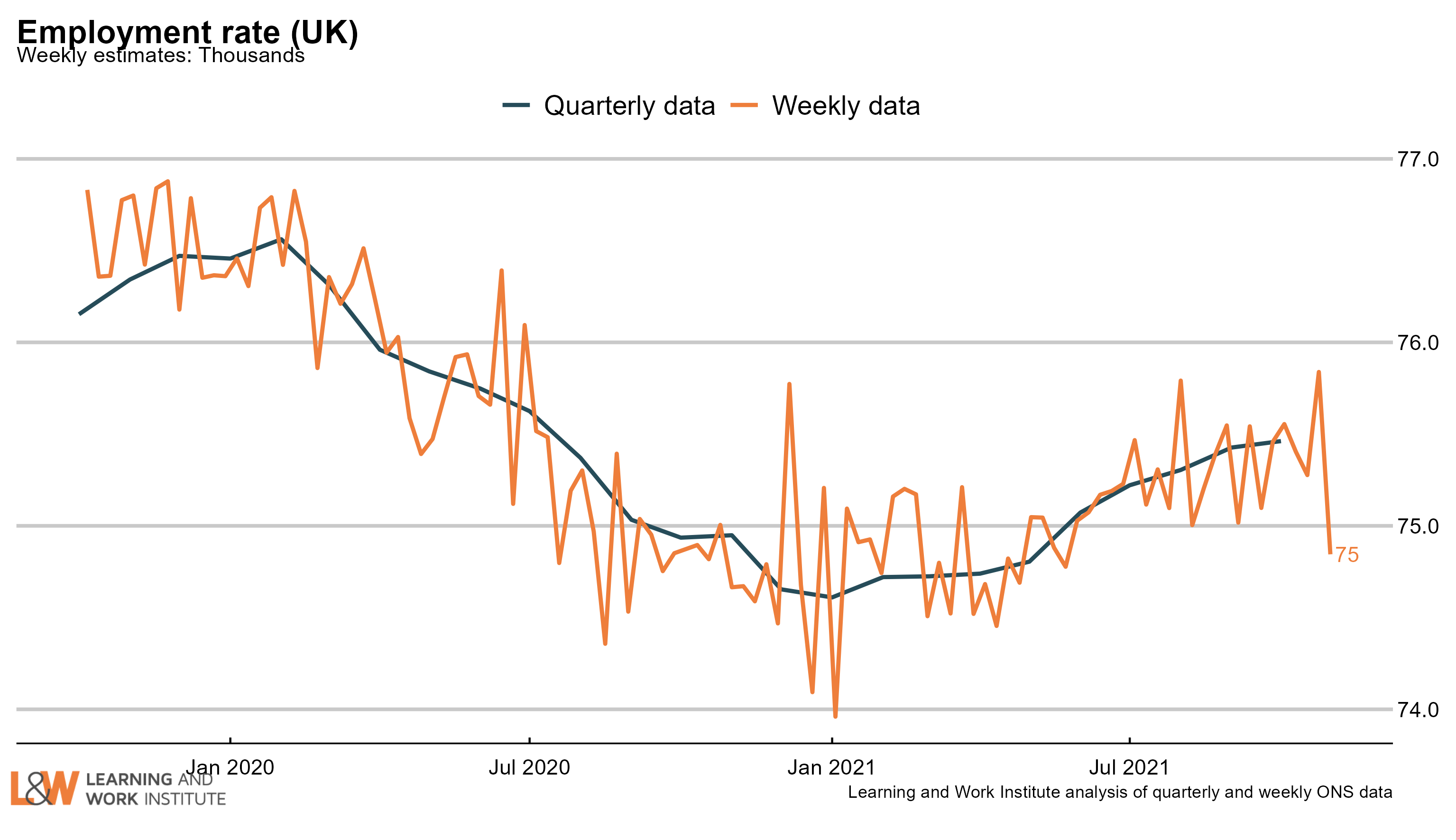 |
 |
Chart 15: Economic inactivity – the long-term sick or disabled
The numbers of people who are economically inactive, that is, not working and not currently looking for work, who are long-term sick or disabled has risen sharply in the last three months to 2.26 million working age people.
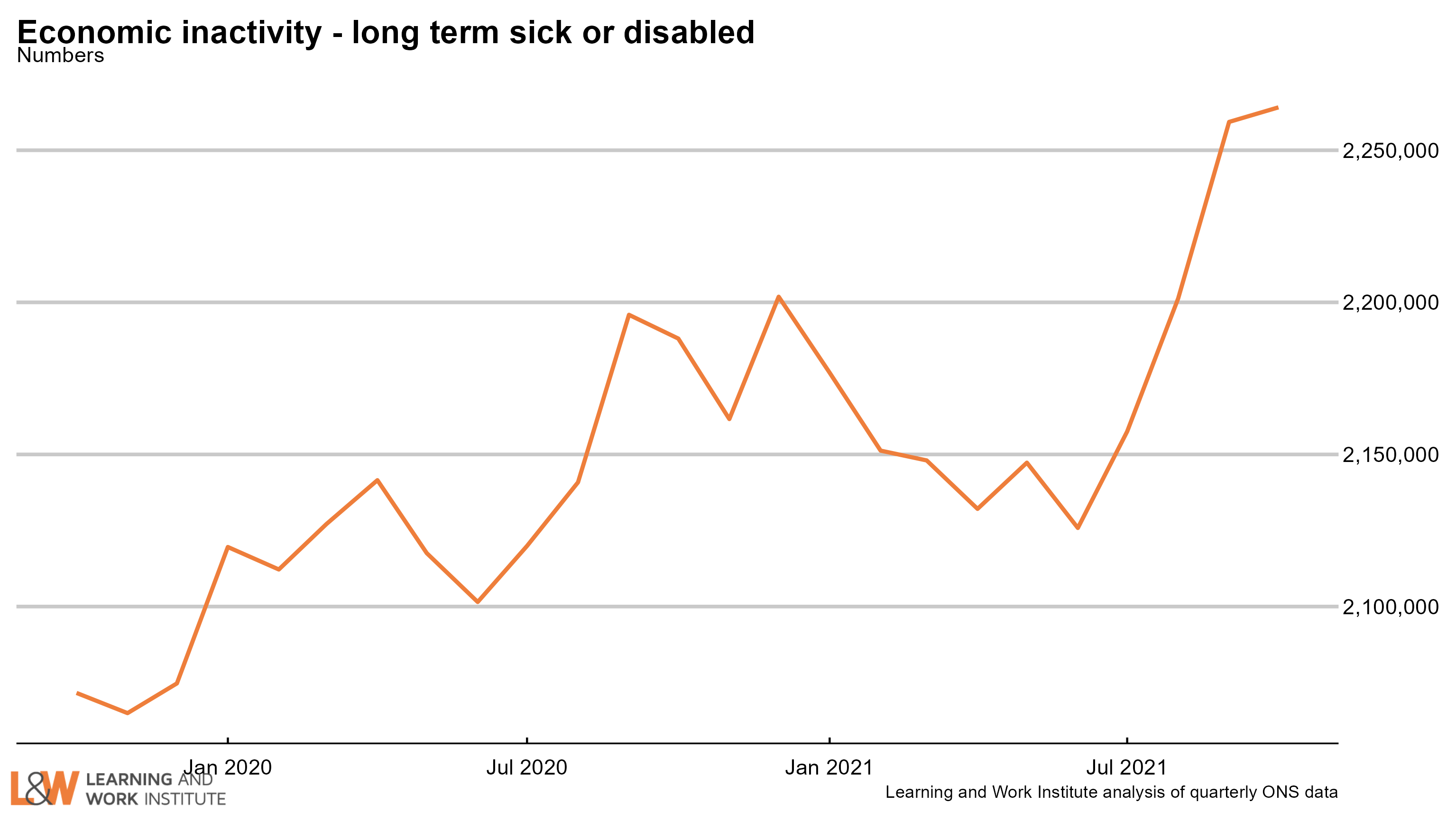 |
 |
Chart 16: Economic inactivity – people looking after family
The survey figures showing those looking after family and not doing paid work or looking for paid work had been trending downwards but has started rising.
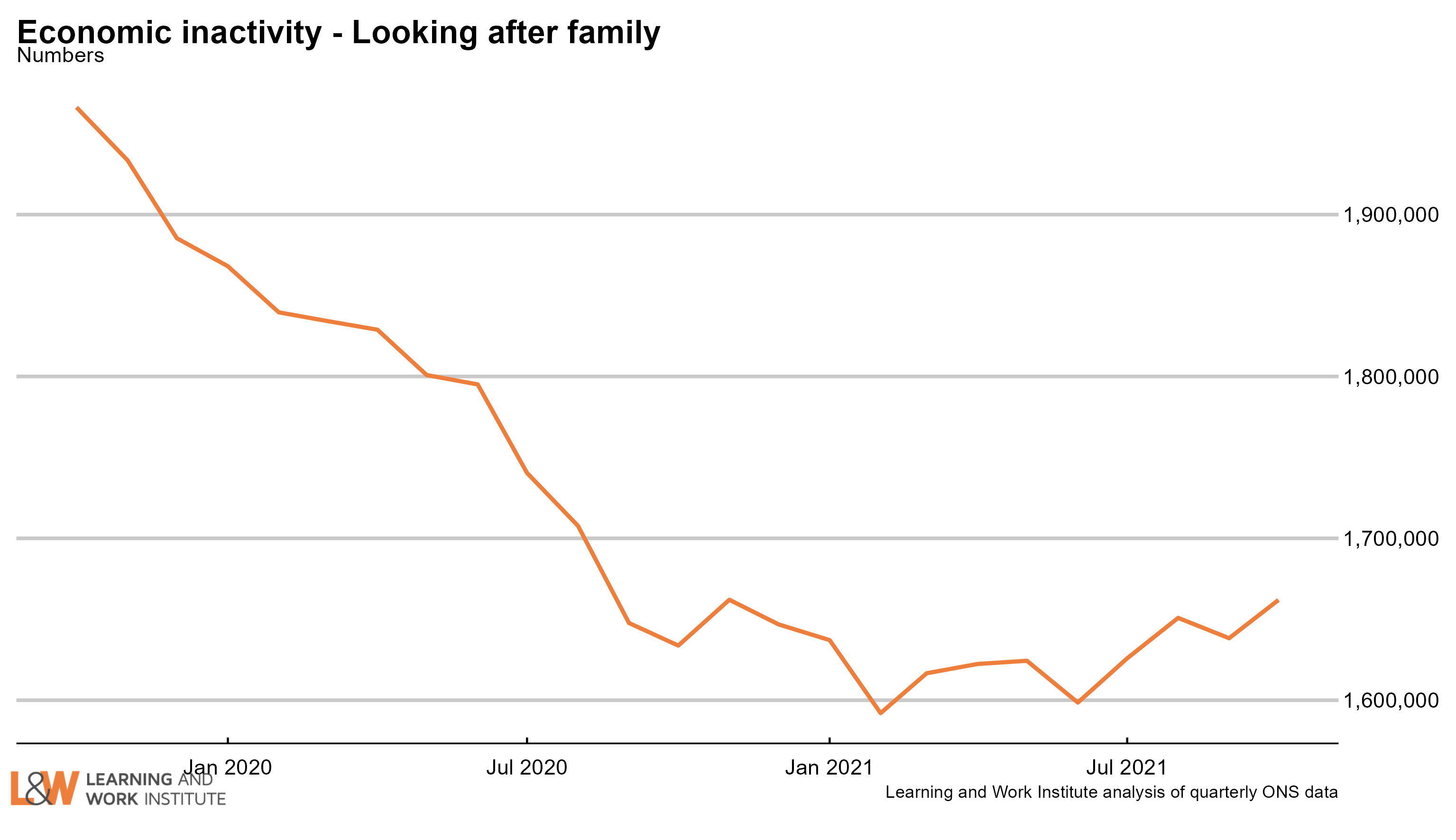 |
 |
Chart 17: Economic inactivity – other inactive
In the Coronavirus period, people who were not working or looking for work due to Covid were included in this group. The number in this category increased sharply at the time, and has continued at a high level. The increase over the pre-pandemic level is now 136,000.
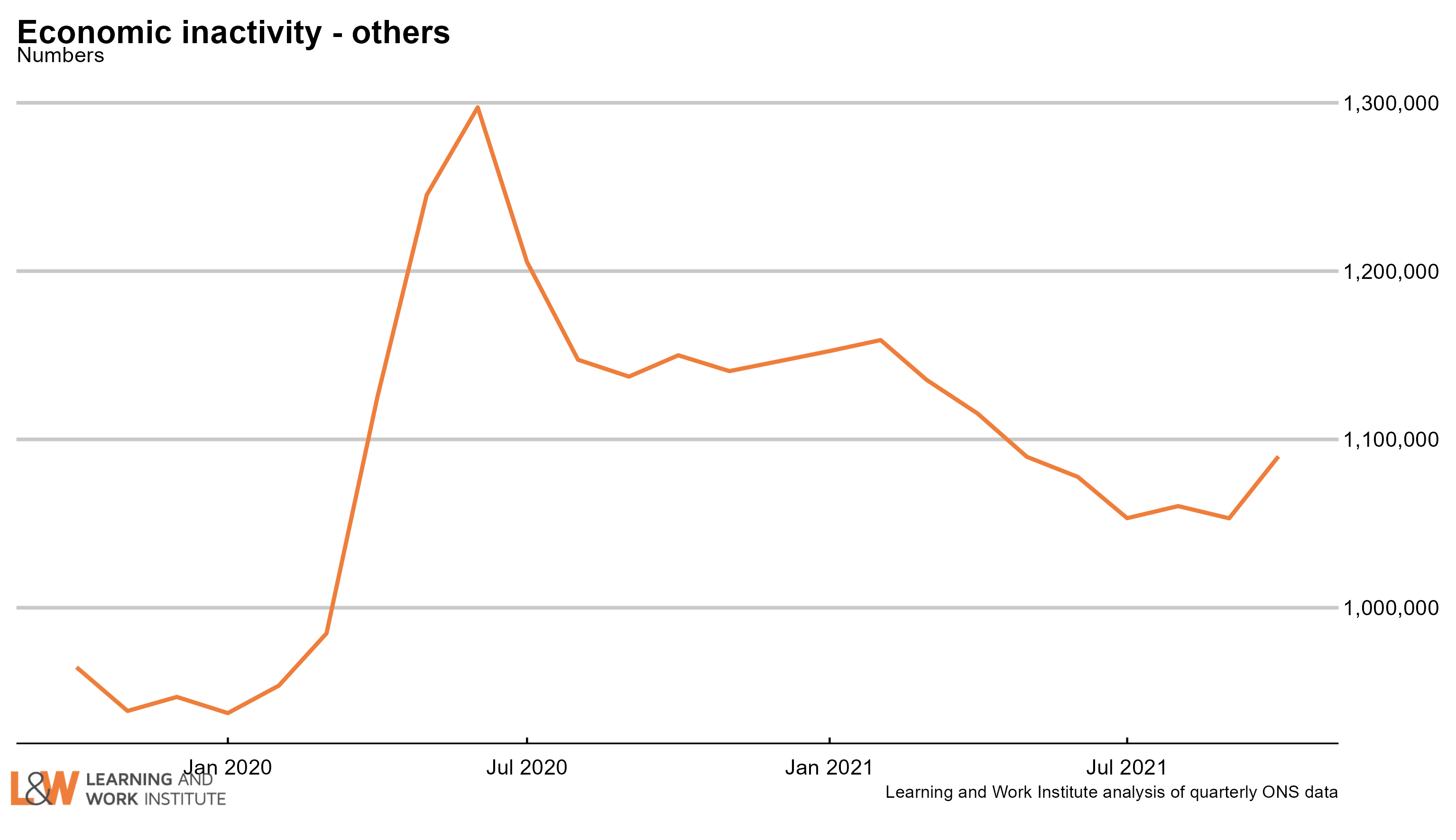 |
 |
Chart 18: Employment rate two-year change in regions – August to October 2021
Compared with 2019, three regions showed a rise in the employment rate, led by the Eastern region and London. The employment rate fell in 9 regions, led by the South West and Northern Ireland. 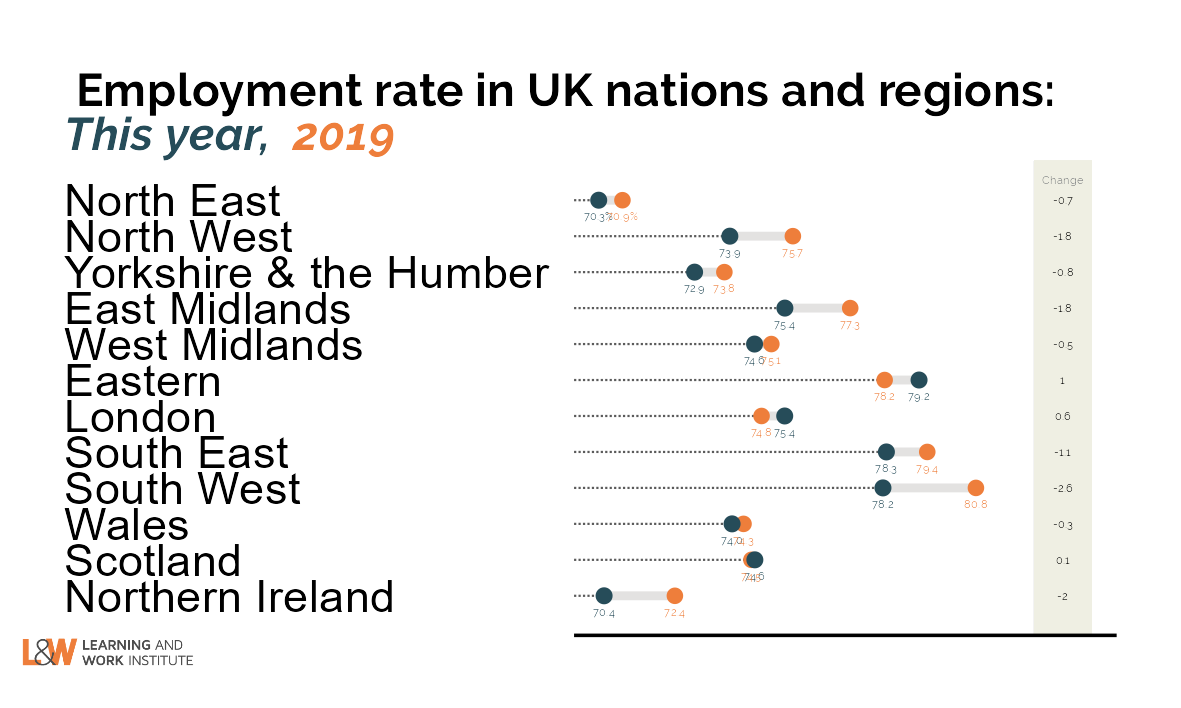 |
 |
Chart 19: Unemployment rate two-year change in regions – August to October 2021
Compared with 2019, nine regions showed a rise in the unemployment rate, led by Northern Ireland, London and the South East. The unemployment rate fell in one region, the North East. The remaining regions were unchanged. 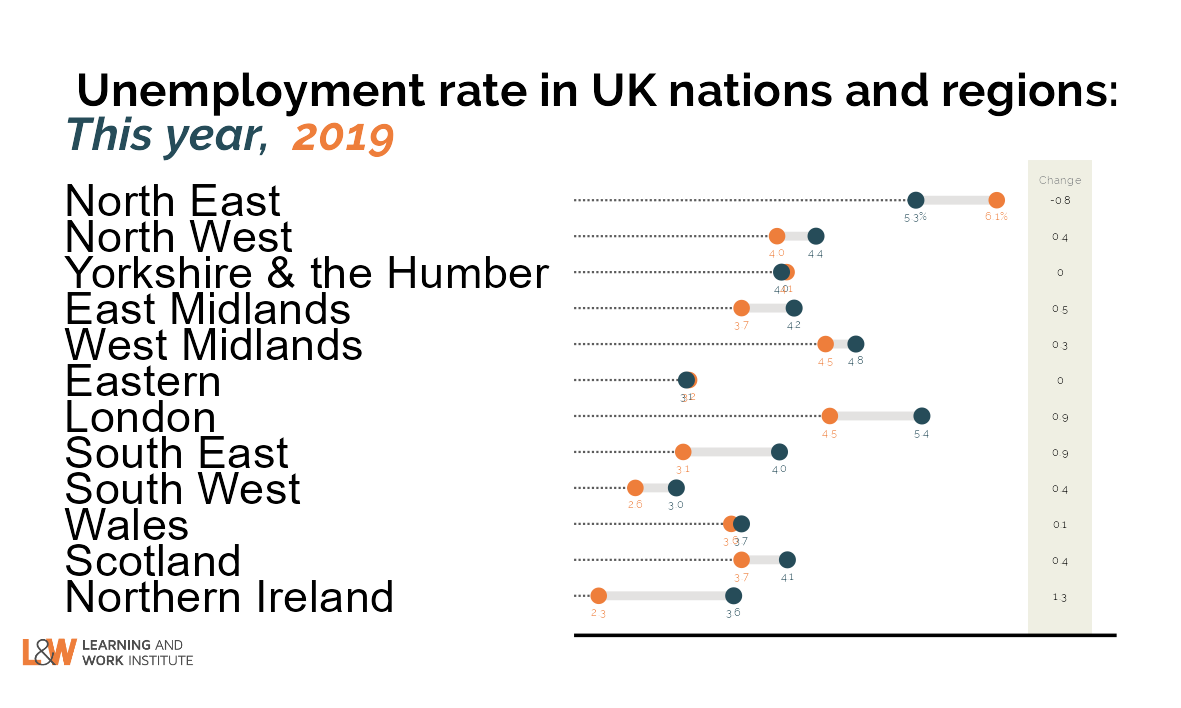 |
 |
Chart 20: Inactivity rate two-year change in regions – August to October 2021
Compared with 2019, nine regions showed a rise in the inactivity rate, led by the South West, the East Midlands and the North West. The inactivity rate fell in three regions, led by the East and London. 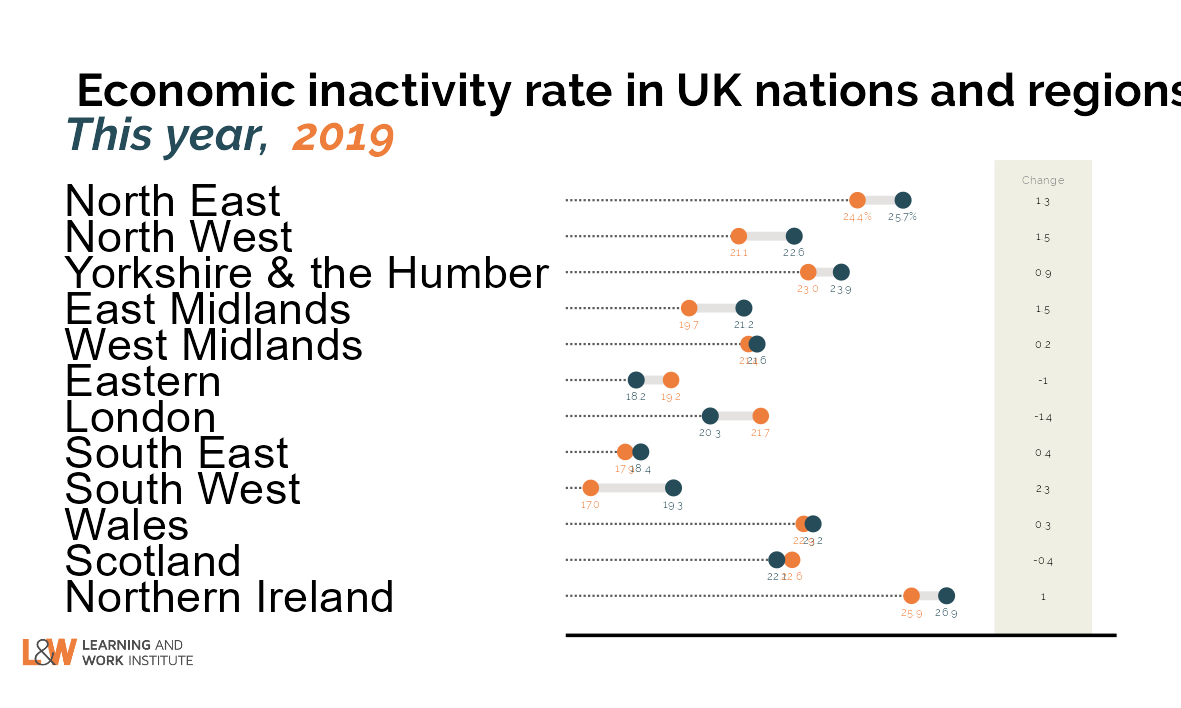 |
|
This newsletter is produced by Learning and Work Institute and keeps readers up to date on a wide range of learning and work issues.
If you have any questions, contact Paul Bivand
© 2021 Learning and Work Institute. All rights reserved. To subscribe click here
To view this email in your browser click here |
 |





















